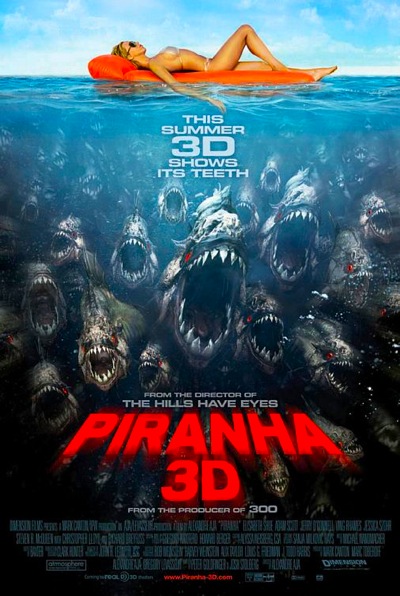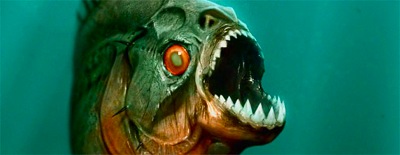[Editor’s Note: LFM Editor Jason Apuzzo has the day off. In his place he’s invited an old friend, Professor Jacques de Molay, to review Piranha 3D. As long-time Libertas readers may recall, Jacques is a Professor of Cinema & Neurosemiotics at the University of Northern California, and is a widely recognized Marxist intellectual.]
By Jacques de Molay. Bon jour, Libertas readers. Due to LFM Editor Jason Apuzzo’s vacation, and the fact that Piranha 3D is directed by the subversive French auteur Alexandre Aja, I have been asked to review this striking new film for the bourgeois film forum Libertas.
It could be said that the subject of Piranha 3D is ‘consumerism,’ albeit consumerism that is contextualised into a dialectic that incorporates within it both “T” and “A.” Except that in the case of Aja’s provocative, neo-deconstructionist exercise, female “T & A” in Piranha 3D is itself the object of consumption – as well as being approximately 10 meters high, unclothed and in three dimensions.

Aja understands that in America’s capitalistic society, the chief object of consumer desire and fetishizing is female flesh, itself. By thereby ‘incorporating’ into his film such pre-commodified females as Kelly Brooke (ooh-la-la!), Riley Steele, Ashlynn Brooke, et al as objects of ‘consumer’ desire in his film, Aja boldly poses the question: who are the ‘real’ consumers depicted in Piranha 3D? Are ‘we’ ourselves the piranhas here? And if so, what does this say about the state of deconstructive, post-capitalist feminism (i.e., whose ‘asses’ are being hung out to dry here?)
Piranha 3D takes place in the fictional bourgeois community of ‘Lake Victoria’ (substituting for Lake Havasu), a repressive middle class haven of Bush’s America – note the proliferation of police, armed with tasers (“Don’t taze me, bro!”) – that swells from a population of 5,000 to approximately 50,000 each year for the annual teen rite of ‘Spring Break.’ This annual bacchanal – which both legitimizes sexual profligacy, yet contains it within the strict confines of the corporate calendar – provides the ultimate ‘feeding frenzy’ for the film’s ‘consumer class,’ the piranhas. For the piranhas, the teens of Lake Victoria are truly ‘pieces’ of ass.
Early in the film we are introduced to our ‘hero,’ a classic WASP teen of the American middle classes named ‘Jake,’ played by Steven R. McQueen – who is the grandson of the famous actor Steve McQueen. And thus immediately one is reminded of the elder McQueen and his appearance in 1958’s The Blob, another film which thematized the devouring of teenage flesh by an insatiable ‘consumer’ beast. [Set to the music of Burt Bacharach.]
We are also introduced to another ‘hero,’ Jake’s mother, a female sheriff played with gruff brio by Elisabeth Shue. Shue’s sheriff is a classic figure of Bush’s America, drilling martial ‘responsibility’ into her son and prudishly shielding him from on-line porn. We practically expect ‘Jake’ to enroll in Jerry Falwell’s Liberty University by the time the film concludes.

In a scene evocative of 1957’s The Monster That Challenged the World (another film subtly promoting America’s military-police state), an earthquake at Lake Victoria collapses the ocean floor (the Wall Street collapse?) and opens an underwater chasm, unleashing an enormous swarm of ancient piranhas (releasing unholy forces from the capitalist id?). These savage aquatic creatures, possessed of unexpected shrewdness and cheeky charisma, have ostensibly lain dormant as eggs for millions of years – much like the flash-frozen, fried fish meals so popular in Western capitalist economies.
Soon enough, however, the ‘consumed’ will themselves become the consumers.
After the earthquake, these ‘unleashed consumers’ immediately surface … and confront actor Richard Dreyfuss, reprising his role as ‘Matt Hooper’ from Jaws. And thus the first character killed in this fable of Bush’s America is, predictably: the liberal Jewish intellectual.
In short order, however, we learn that the true villain of Piranha 3D is not so much the prehistoric fish … so much as it is a character named Derrick Jones (Jerry O’Connell), based ostensibly on “Girls Gone Wild” mogul Joe Francis. This character – who attempts to lure young Jake into his world of commodified females, alcohol and drug use – takes Jake, his benign romantic interest ‘Kelly’ (Jessica Szohr), and models ‘Danni’ and ‘Crystal’ (the astonishing Kelly Brooke and Riley Steele, respectively) into the isolated, outer reaches of the lake.
It is here – in this bucolic setting – that the signature sequence of Piranha 3D takes place, the sequence which will be talked about for years to come among film critics, academic semioticians, and older men wearing raincoats: a campy, underwater ballet between Ms. Brooke and Ms. Steele, performed to the strains of Léo Delibes’ “Flower Duet,” conducted fully naked and in 3D. Surely this will be remembered as Aja’s ‘Odessa Steps’ sequence in years to come, his defining moment as a visionary. I am not aware of anything resembling this sequence in the history of the cinema, at least in terms of the fetishizing of female flesh within the strictures of normative capitalist discourse – not to mention within the classical music canon.
It is here especially that Mr. Aja’s meaning becomes only too plain: we ourselves are the ‘piranhas,’ ogling after this commodified flesh. Here one begins to appreciate the sophistication of Mr. Aja’s vision, in comparison to the similarly 3D-mad James Cameron. Aja dispenses with Cameron’s tame, prudish alien titillation – and gives us the ‘real’ thing, in vivid three dimensions, as only a French director could.

Soon enough the piranha ‘consumers’ begin wreaking their havoc. I have been informed by Editor Apuzzo that one of the conventions of bourgeois film criticism is not to ‘give away’ the ending, so we will limit our remarks to revealing that the Derrick Jones/Joe Francis character – clearly Piranha’s scapegoat in terms of channeling the audience’s anxiety over the exploitation of female flesh – comes to a uniquely spectacular end (aided here by 3D technology) … in which his male member is chewed off with gusto by the piranhas … who subsequently spit the member out, apparently as disgusted by Mr. Jones’/Francis’ exploitation of female labor as is the audience. [The piranhas’ refusal to ‘devour’ the male member also confirms suspicions that the fish are, in effect, masculine and heterosexual in sensibility. Are they fanboys, perhaps?]
Mr. Aja’s critique is thereby made plain: after the Wall Street collapse, commerce in today’s capitalist society can only end in bloody apocalypse – a farrago of bikini tops, chewed limbs … and shattered ideals.
On the acting front, special kudos should be given to Ving Rhames – the sturdy character actor who valiantly combats the marauding fish, at one point with an outboard motor – and to Christopher Lloyd of Taxi and Back to the Future fame, playing the stock ‘mad scientist’ character. His presence in American mainstream cinema has been missed.

Given the repressive nature of American society in the long aftermath of the Bush years, Piranha 3D should likely have been rated NC-17, if not an outright X. In my less restrictive homeland of France, where we are better prepared to appreciate such material, I assume there will be a ‘French’ cut of the film – perhaps featuring an extended version of the breathtaking ballet sequence … and perhaps replacing the Delibes with Bizet.
[Editor’s Note: here at Libertas we are committed to providing a platform for freedom of speech, and a diversity of ideas – including those of today’s progressive left. We’d like to thank Prof. de Molay for his unique contributions to our understanding of the new film Piranha 3D.]
Posted on August 20th, 2010 at 7:10pm.
